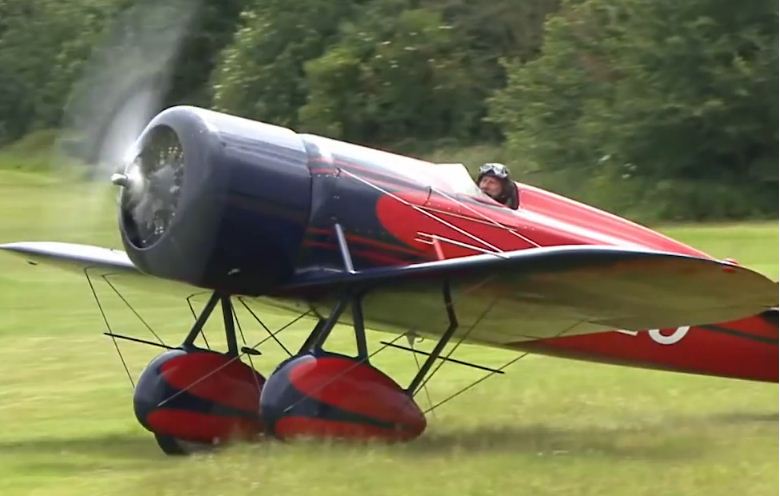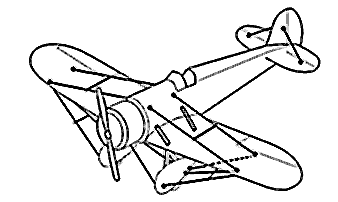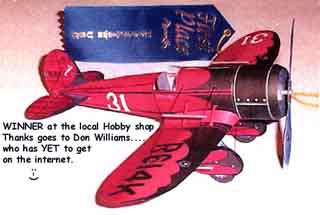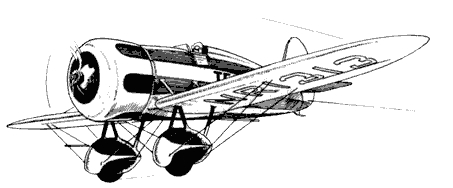

Travel Air Mystery Ship - $$5.95
The Travel Air Type R "Mystery Ships" were racing airplanes built by the Travel Air company in the late 1920s and early 1930s. They were so called because the first plane of the series (R614K) was built entirely in secrecy and kept under cover for the 1929 Cleveland Air Races.
Doug Davis
and the Travel Air (Travelair) Mystery Ship

The Travel Air (Travelaire) Mystery Ship
was a sight to be seen
and a truly phenomenal Racing Airplane..
Air Race spectators witnessed the beginning of a new era in commercial aviation. This was in the form of a sleek racing job built by the Travel Air Company of Wichita, Kansas. This racer, whose design and construction began in 1928, earned the name Travel Air "Mystery Ship". Its design and construction was a closely guarded project at the factory and even as it landed at the Cleveland airport to participate in the 1929 air races, the racer was hastily rolled into the hangar and hidden with a canvas cover.

This is the single sheet model at 1:46 scale. Model includes
seat and instrument panel. A tricky little feature is that the
cowling slides of to show off the double banked Wright Radial.
The flying wires were made from stiff hobby wire available from
any hobby shop. Goes together easily.
This is the Travel Air Mystery Ship model that won the FG Modeling Madness (FGMM) 2010 best in class prize. Congratulations Douglas !! |
|
 |
 |
 |
|
Meet Doug Davis the famous pilot who flew the Mystery Ship to record speeds 1929. On the next page is Dougie shaking hands with Mr Bendix. You can use him as an accessory to your model.
In the summer of 1929, the air over Cleveland, Ohio buzzed with the staccato sound of racing aircraft in the free-for-all event of the National Air Races. Thompson Products Company had donated the trophy and it would be one year later before the Thompson Trophy Race, as such, would become a major event.
At the end of 50 miles, the winning aircraft, a Wright Whirlwind
powered Travel Air, had covered the course at a speed of 194.90 mph
and its pilot, Doug Davis, became the first recipient of the coveted
Thompson Trophy. This feat is all the more remarkable because the
Travel Air became the first commercial aircraft to beat the finest
of both the Army and Navy entrants.
Designed and constructed in total secrecy, thereby earning the title of Mystery Ship, the aircraft brought low-wing monoplane (one wing) engineering to air racing. This type of aircraft endures to this day in the form of small private planes to the giant transports. It was this win that foreshadowed the end of the dominance of the rugged biplane (two wings). For these reasons this plane truly deserves a place of honor in any collection of the Golden Age of Aviation.
THE 1929 NATIONAL Air Race spectators witnessed the beginning of a new era in commercial aviation. This was in the form of a sleek racing job built by the Travel Air Company of Wichita, Kansas. This racer, whose design and construction began in 1928, earned the name Travel Air "Mystery Ship". Its design and construction was a closely guarded project at the factory and even as it landed at the Cleveland airport to participate in the 1929 air races, the racer was hastily rolled into the hangar and hidden with a canvas cover.
 Two young engineers, Herb Rawdon and Walter Burnham, designed the
ship and under the guidance of Walter Beech, president and founder
of the Travel Air Company, the racer was built rigidly to design
specifications. It is a surprising fact that on its first test flight
the racer exceeded the calculated airspeed by 15 percent.
Two young engineers, Herb Rawdon and Walter Burnham, designed the
ship and under the guidance of Walter Beech, president and founder
of the Travel Air Company, the racer was built rigidly to design
specifications. It is a surprising fact that on its first test flight
the racer exceeded the calculated airspeed by 15 percent.
The little red and black racer, low-wing in design, engine cowled with an NACA streamlined cover, and the wheels fully enclosed in streamlined pants was a picture of speed. During construction two other types of cowling were tried but the NACA type proved to be the most efficient.
The Travel Air "Mystery Ship" not only introduced the NACA cowl and wheel pants to commercial aviation but also contributed toward the trend of low-wing military and commercial airplanes. When the racer was first unveiled many prominent people in aviation considered the airplane undersized and underpowered. The trend thus far had been more power for more speed. However, the record of this ship is a matter of history and many a designer ate crow over the remarks made about the "Mystery Ship".
 The fuselage was constructed of steel-tube and plywood covered, and
the wings all wood and also covered with plywood. The wing span was
29 ft. 2 in. The first famous "Mystery Ship", NR614K-race
No. 31, actually had two sets of wing panels. One set for closed course
racing and the other for cross country flights and competition. The
closed-course racing wings were about one and one half feet shorter
in span and three inches narrower in chord. NR-614K's short wings
were purchased by Shell and were used, as required, through Doolittle's
No. 400. Fuselage length was 20 ft. 2 in. and it was 7 ft. 9 in. high.
Its empty weight was 1,475 lbs and a gross weight of 1,940 lbs
The fuselage was constructed of steel-tube and plywood covered, and
the wings all wood and also covered with plywood. The wing span was
29 ft. 2 in. The first famous "Mystery Ship", NR614K-race
No. 31, actually had two sets of wing panels. One set for closed course
racing and the other for cross country flights and competition. The
closed-course racing wings were about one and one half feet shorter
in span and three inches narrower in chord. NR-614K's short wings
were purchased by Shell and were used, as required, through Doolittle's
No. 400. Fuselage length was 20 ft. 2 in. and it was 7 ft. 9 in. high.
Its empty weight was 1,475 lbs and a gross weight of 1,940 lbs
Part of the gross weight was accounted for by the 47 gal. fuel capacity and the six gallons of oil. This gave the racer a wing loading of 15.5 lbs/sq. ft. and with the 300 hp 975 cu. in. displacement Wright J6-9 that had been upped to over 400 hp, it had a power loading of 4.6 lbs/per hp. The increase in the Wright R- 975 to 400 hp plus was obtained by augmenting the compression ratio and the speed of the supercharger. The sleek little speedster had a top speed of 235 mph and a landing speed of 73 mph.
 On September 2, 1929, the "Mystery Ship", with its super
smooth finish, was rolled out of the hangar and with Doug Davis of
Atlanta, Georgia at the controls, lined up for the Thompson Cup Race-Event
26. Entering the low power racer in this event against the high powered
military ships was like throwing it out to the wolves. But Davis proved
to the world that the "Mystery Ship" could perform and went
on to win the event at a speed of 194.9 mph (one lap flown at 208.69
mph). The military entries finished a bad second and fourth behind
him, with speeds eight to 30 mph less than that of the "Mystery
Ship".
On September 2, 1929, the "Mystery Ship", with its super
smooth finish, was rolled out of the hangar and with Doug Davis of
Atlanta, Georgia at the controls, lined up for the Thompson Cup Race-Event
26. Entering the low power racer in this event against the high powered
military ships was like throwing it out to the wolves. But Davis proved
to the world that the "Mystery Ship" could perform and went
on to win the event at a speed of 194.9 mph (one lap flown at 208.69
mph). The military entries finished a bad second and fourth behind
him, with speeds eight to 30 mph less than that of the "Mystery
Ship".
This was the first time in the history of air racing that a civilian racer had outraced a military job. This was a big moment for the builders of civilian aircraft and at the same time opened the eyes of the military to the fact that some changes were dictated. The Army and Navy entries were modified high speed pursuits, revamped just for this race and the little Travel Air with far less power had won by a large margin-and in the course of the race had recircled one of the pylons.
The balance of 1929 and in 1930 the NR-614K appeared in many air meets around the states. Clarence Clark, who flew the original test fights on the "Mystery Ship", divided the cockpit time with Dale "Red" Jackson during those demonstrations. Both did an excellent job doing acrobatics and speed runs for the air fair crowds throughout the country. During the 1929 and 1930 tour the ship was sponsored by the Gulf Oil Company and traveled with the Curtiss Wright Exhibition Company. The ship was unchanged in 1930, except for the Curtiss-Wright and Gulf Oil insignias. It did not make an appearance at the 19:30 National Air Races.

It did appear at the 1931 National Air Races. Walter Hunter was
the pilot and a new black and orange paint job changed the appearance
of the racer. The ship caught fire in the air while Hunter was
testing it prior to Thompson Trophy Race and Hunter was forced
to bail out. It was rumored that the fuselage was gas soaked.
that an area between the fire wall and engine was also fuel soaked.
These areas should have been thoroughly cleaned, but not enough
time existed before the race and this was not done. This could
have been the reason for the fire but the cause was never definitely
determined.
Burnham, one of the original designers, had future plans for 614K. He planned to place a 535 hp Wasp JI the ship and increase its speed to approach the 300 mph class with the landing speed raised to only 85 mph. The crash curtailed these plans and were not attempted on any of the other "Mystery Ships".
Travel Air produced a second "Mystery Ship" and it also was present and unveiled at the 1929 National Races. This one was powered by a six cylinder Chevrolair. manufactured by Arthur Chevrolet Aviation Mot Corporation of Indianapolis, Indiana. This was a test model six cylinder inverted inline engine. Designated D-6 it developed 165 hp and 2175 rpm, was air cooled had a 508 cu. in. displacement. The Chevrolair powered"Mystery Ship" has the same dimensions as 614K. The cowl to fuselage flare used on 614K was not needed 613K as both fuselages were built for inline engines.

This "Mystery Ship" was painted red and carried licence number NR613K and race No. 32 for the 1929 Nation Both of these ships were known as the "Mystery S" but were actually Travel Air Low-Wing R's. Doug Davis flew (Chevrolair powered job to first place in the Experimental Ship Race. He turned in a speed of 113.38 mph to beat Ed Heath in the "Baby Bullet". Clarence Clark took his turn in the Chevrolair powered job and placed third in the 510 cu. in. displacement race. Following Vern Roberts and Stub Quinby in Warner powered Monocoupes, he was clocked at 126.14 mph.
After the 1929 National Air Races the Chevrolair engine was pulled out of the "Mystery Ship" and sent back to the Indianapolis factory and the airframe was shipped back to Wichita. At Wichita a Wright J6-7 was placed in the ship and was purchased by the Barnes family. They made the purchase through an aircraft dealer in Los Angeles. The ship was now painted yellow and red and appeared from time to time with a Townsend ring covering Wright. Pancho Barnes flew the ship to many records the west coast and appeared at one race meet at Kansas City. She flew the ship with or without the speed ring as well as with the long and short wings. Pancho Barnes used the short wings when setting a woman's speed record August 5, 1930 at 169.19 mph.
NR-613K was bought by Paul Mantz and was used in many aviation movies, playing the part of foreign fighter aircraft, Schneider racer and many others.

In 1930 the Shell Oil Company ordered a Travel Air "Mystery Ship" to be used at air races and meets to advertise their products. Jimmy Doolittle and Jimmy Haizlip gave stunting exhibitions with the racer and Haizlip flew it in the 1930 Thompson Race. The ship was licensed NR-482N and was identical to the 1929"Mystery Ship" except that the NACA cowl had been lengthened.
The racer was painted with the Shell colors of red and yellow and carried race No. 35 for the National Air Races in 1930. Jim Haizlip flew the Shell job to a first spot in the 1,000 cu. in. displacement race, clocking 183.36 mph and placed second behind Speed Holman in the Thompson Trophy Race with 199.80 mph. He trailed the Laird flown by Holman by only two miles per hour.
Later in the season the ship picked up race No. 26 and was raced throughout the United States by Doolittle and Haizlip. In May, 1931, Haizlip and 482N finished two laps ahead of his nearest competitor. As an added thrill for the crowd, he flew the last few miles and finished the race in an inverted position. The second and third spots went to Casey Jones flying a stock Cessna and Art Davis in his Waco.
 A fourth "Mystery Ship" was purchased by the Texaco Company and was
perhaps the most famous of the five. This was Frank Hawks' "Texaco
13". Frank Hawks had flown Mr. Hull, president of the Texas Pipe
Line Co., and won a berth as superintendent of aviation for the
Texas company. "Texaco 13" was identical to the other Mystery
Ships", but included a cockpit full of special instruments for
long distance flights, so the ship was heavier than the other
three.
A fourth "Mystery Ship" was purchased by the Texaco Company and was
perhaps the most famous of the five. This was Frank Hawks' "Texaco
13". Frank Hawks had flown Mr. Hull, president of the Texas Pipe
Line Co., and won a berth as superintendent of aviation for the
Texas company. "Texaco 13" was identical to the other Mystery
Ships", but included a cockpit full of special instruments for
long distance flights, so the ship was heavier than the other
three.
The cockpit was fully enclosed and set flush with the top of the fuselage. The racer was painted a Stearman vermillion and white, with a blue stripe separating the red and white. The ship had two different paint jobs, the first being on the ship a very brief period. Hawks hit some wires and cracked the ship u cp. It was repaired and repainted at this time. On two occasions he cracked the ship up, one time injuring himself very seriously. He never did well at the Nationals.
But Frank Hawks and the Travel Air "Texaco 13" did set hundreds and hundreds of cross country records. Not only in this country but also in England and Europe. The European pilots were amazed at the records he set day after day. They had been setting records over short courses but had nothing that would take this long day after day grueling grind. After Hawks' death, in another aircraft, the racer was given to the Chicago Museum of Science and Industry where it hangs as a symbol of the racing airplane that started the trend toward low-wing military and commercial airplanes.

 |
 Some good closeups from a model magazine |


